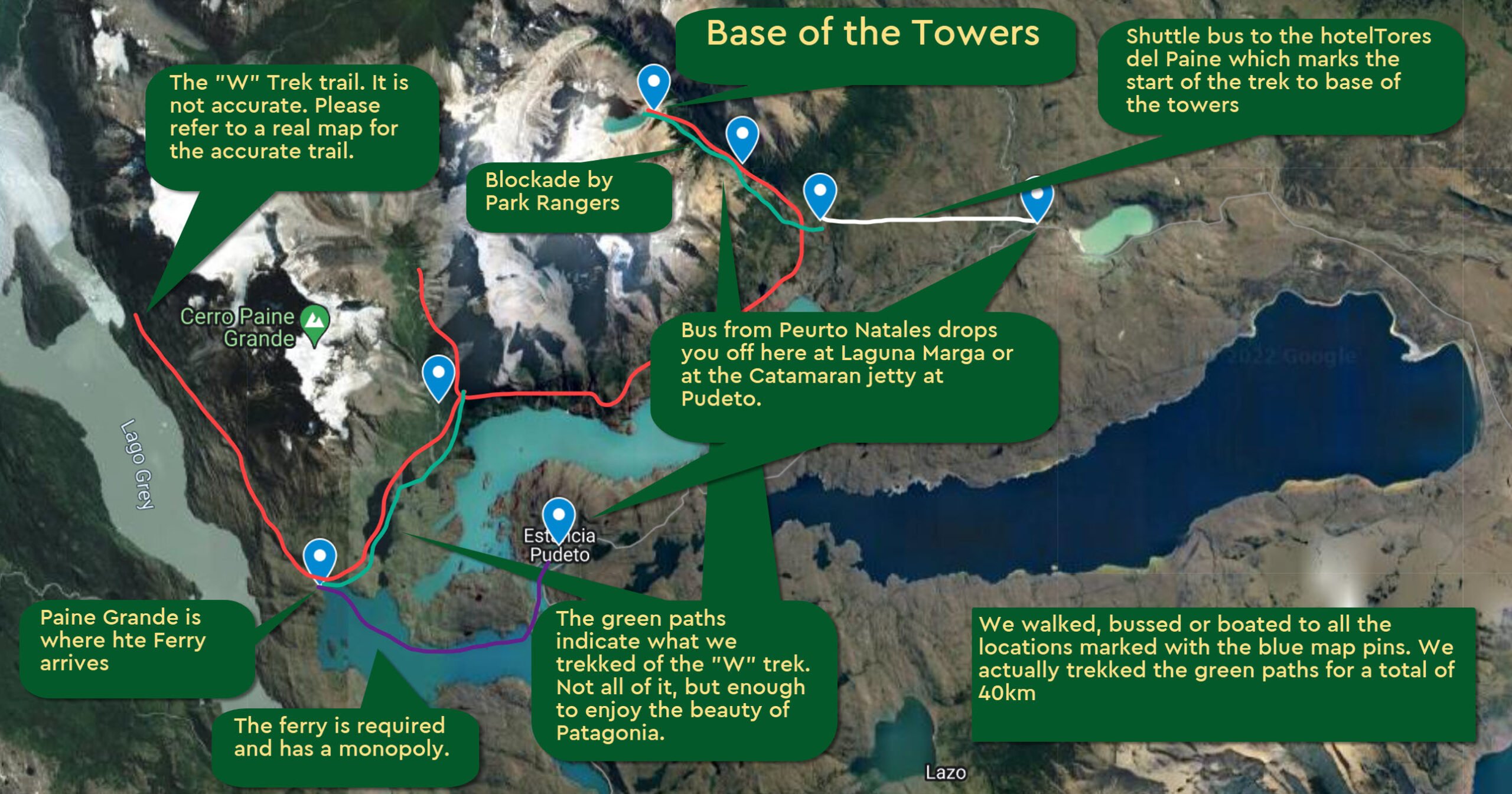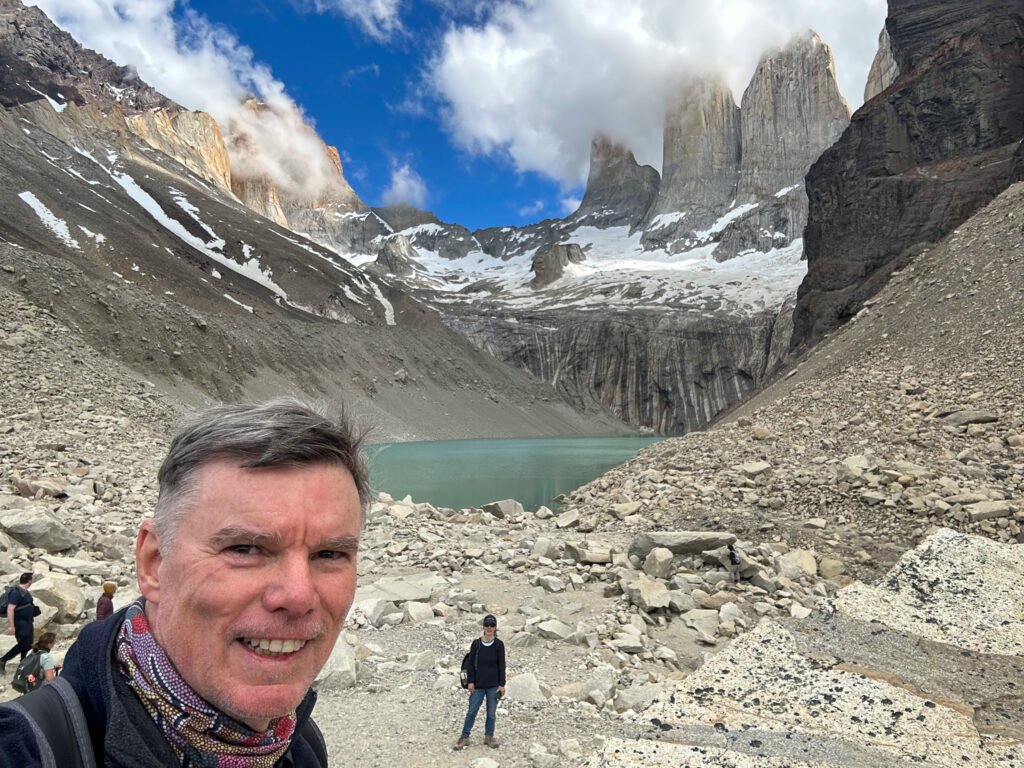Patagonia, Park Ranger Strike Part 2

Conscious that I am posting these articles to LinkedIn, some will justifiably argue this kind of post has no place on a platform (touch wood, I’ve had no angry responses and LinkedIn applauds me for being active)… I believe there is a work-related theme or messaging in all of this.
Later, as I describe the physical pain of a moderately fit 61-year-old struggling to keep up with young couples bounding up the mountain slopes like mountain gazelles (I have discovered that “agile alpaca” is a bit of an oxymoron, despite sounding nice and appropriate for this region), the important thing is to live your best life. Working hard in a course to achieve the best results you can, providing satisfaction to as many people you can influence, being creative and enjoying the fruits of that creativity or endeavour and as LinkedIn and its members demonstrate through posts, celebrate personal achievements, impacts with others in your workplace and beyond.
If you don’t want my little workplace thought piece and just want the Torres del Paine adventure part 2, click here.
The young professionals we have met on this journey are experiencing not just a holiday, but a life-changing experience that adds to their global experience, tolerance, adaptability and I suspect a bunch of other useful employability skills and capabilities. The variation in location and culture also shapes our creative thinking perspectives by being exposed to everything from art and process as strangers in a strange land which is a term I use repeatedly and with some joy.
With the number of personality tests inflicted upon us, I would be interested in comments on how trips away from your usual domicile, foreign exchange postings, internships etc that clearly deliver benefits to both employee and employer, can be cultivated in a way that the employee can continue to develop within a company and also be offered the dopamine rush of travel, expectation, adventure and challenge in a situation we have chosen.
There are those who would not venture into a foreign country where they don’t speak the local language and Smarttraveller is suggesting that you avoid travel to that country, or try to break through a striking park ranger blockade (Yes, more on that shortly). Those folks should not be subjected to placement in work situations without consultation or consent, or as a choiceless option (another oxymoron) – BUT – I see it take place in a number of work environments, including my own. As managers, we sometimes demonstrate poor choice in pushing people into “development opportunities” when folks are very happy in their job, living their best life and doing their best, which will be for the best of the company and client…
…while the person who thrives on being thrown into new situations and adapting to respond with a solution is kept “in a box” because in order to achieve outcomes, sometimes the path needs to be more agile than procedural – to use a programming metaphor.
So what has led to this work-related digression? A wobbly table in our hotel restaurant. I am that person who without fail can walk into a restaurant and after carefully surveying the tables on offer, magically is able to select the table with the wobble. Believe me it is not intentional. If you only dine in restaurants where you are ushered to a specific table, without wobbles of table or waiter and your napkins are cloth and not paper serviettes, don’t read on as this is my real life experience…
I sit at the wobbly table and after discovering the wobble I have 4 choices.
- move to another table
- summon the waiter and try to get him to fix it
- fix it myself or
- put up with the wobble in silence, hoping my coffee doesn’t spill.
As I tore half a paper serviette and folded it to the correct thickness, placing it under the offending table leg, I wondered how many folks would make the different choices listed above. I then related this to activities and events in the workplace.
Should I have delegated? Was the task within my capabilities? It was only putting a napkin under a chair leg, but if it was building a football stadium more planning, assignment, execution and checking would be required (as it is difficult to stabilise a wobbly stadium).
In our everyday work lives, regardless of our positions as leaders/managers or workers within a team, it is my belief that if you see something wrong and can fix it, take the initiative. Don’t turn it into an unnecessary activity involving more people and processes than is required.
I came back to the same restaurant the next day and sadly, picking another table, found that too was wobbly. I fixed that too with the same paper napkin technique. Heartwarmingly, the small napkin wedge placed under yesterday’s table was still silently performing its function of providing stability for the strangers consuming breakfast at that table.
Tomorrow more strangers will benefit from the two tables now stable in the restaurant. It is small stuff but it can provide a positive lasting knock-on effect. Something to consider for work and I suppose life in general.
Okay,
Part 2 – Patagonia, Park Ranger Strike
If you need to read part 1, it is here.
Invigorated after a day of relaxation in Puerto Natales, we decided to take the risk on our last day in Patagonia to attempt the trek to the base of the towers. We scoured the internet for any update on the park ranger strike and couldn’t find anything suggesting that the blockade was over. The worst that could happen was that we would be turned back.
We packed our picnic of bread, cheese, ham, water and biscuits and headed off to the bus station at 6am to purchase bus tickets for the ride out to Laguna Amargo (Bitter Lake) which is where the busses travelling from Puerto Natales generally take folks. From there we planned to catch the shuttle to the staging point and cafe near the Hotel Las Torres.


At the bus station in Puerto Natales we arrive early, purchase tickets for the 7:15 bus out to Torres del Paine and wait to board. Suddenly Helen notices that the date on the ticket we have just purchased is for last week. We raise this with the lady who has just sold us the tickets and she panics a little. Not as much as we did. This was the last bus out to the park for that day and we now didn’t have seats despite turning up early and purchasing tickets. We were offered a refund and at the same time an extremely relaxed bus driver… the driver of the bus we were booked on indicated something could be worked out.
The bus turned into a kind of magical chairs bus with folks shuffled around and suddenly everyone had a seat. As I write this I repeat the deep sigh of relief I felt that at least we were going to get to the park. Helen and I weren’t seated together and I had a chance to converse with a young married couple from Sao Paolo who were actually on their honeymoon.
We arrived at Laguna Amarga and just before we reached that point, we were treated to the spectacle of a reasonably large flock of flamingos. The bus driver slowed down for us to take some pictures.
We arrived at Laguna Amarga, disembarked and jumped onto the small shuttle bus which took us to the Hotel Las Torres, Patagonia. There was a cost for the shuttle and with changing prices I’m reluctant to put a number down – but I must… 3000 Chilean Pesos for the shuttle (one way) and for the bus from Puerto Natales to Laguna Amarga was 10000 Chilean Pesos one way.
We had made it to the start of the trek to the base of the Torres (towers), those classical three mountains that jut out up into the sky. Pachatata or maybe Pachamama was looking after us because the weather was perfect as you can see from the photos. This perfect weather continued throughout the entire day.
So, off we set on our trek, unsure of how far we would get. When you look at the trek on a map, it doesn’t look too arduous – about 9k one way from the trailhead. We do quite a bit of walking and this trek pushed us, so don’t be fooled by low numbers.
There were a few trekkers on the path and some shared concern over the strike and generally adopted the same attitude as us – we had a beautiful day, the scenery was sensational from the get-go and we would go as far as we could.
In addition to trekkers, packhorse trains carry supplies into the Refugio Chileno, a camp about halfway along the trek to the base.
At a point before reaching Refugio Chileno, we met a trekker returning from the base who said that he had set out at 3 am to reach the base and had encountered park rangers who had placed blockades on the trek path, removed planks from bridges and strung wire and ropes across the path to block any trekkers from reaching the base of the towers.
With this disheartening news, we continued to the camp at Refugio Chileno where we stopped and had our picnic. The day was clear and we could see the very tops of the towers in the distance, their lower parts obscured by another mountain.
We foolishly didn’t think that the trek from that point to the base of the towers would take that long. We set off and were walking through a mountain forest after crossing the river when we encountered the first of the barricades. Nothing too serious, some logs across the path. As we pushed on we encountered more barriers and bridges with blockaded passageways or planks taken out of the bridge crossing.
The trek quickly became an obstacle course and along the way, we met three groups of people who had reached the formal blockade protest point where the rangers were turning people back. These folk had opted not to continue and found the rangers intimidating.
At this point, we resigned ourselves to reaching the same point and being turned back. The scenery we had witnessed to this point was outstanding so there were going to be no regrets. We pushed on and before we knew it we were at the crest of a hill (there were many on this trek) and a crowd of about 20 trekkers were gathered around a small group of about 5 rangers with their protest signs and some substantial path damage and obstructions beyond where they were making a stand.
One of the trekking group members was presenting in Spanish what I believe to be the case for why the trekkers should be allowed through. She spoke at length without interruption and when she finished, one of the park rangers responded with the rangers’ side of the story. I was mightily impressed by the civility demonstrated by all involved in presenting points from both sides as if they were involved in a formal debate at a university.
You can view the raw footage of the polite standoff here.
Then suddenly one of the groups of trekkers decided to push through and we followed. There was disappointment on the part of the rangers however neither side resorted to any actions that might be regretted at a later time.
After making our way through the ranger demonstration point, we were confronted with even more elaborate blockades which also appear to have been centred around a natural washaway. Again, video explains what we had to work our way through better than words.
The most challenging of the blockades lay ahead. Ironically once we got through these blockades, mother nature stepped in and put the real challenge of the trek before us. Suddenly we were in fact trekking up steep rocky slopes on our way to the base of the towers.
We still had an hour to go before we reached the summit and once through the forest the climb began in earnest. Already tired from negotiating the obstacles placed by the rangers, we began to struggle with the climb in front of us. Water was low and just for a moment, morale slipped a little as well.
We persisted on the climb and our fellow trekkers, strangers until 30 minutes ago were suddenly joined by this bond of needing to reach the end of the trek. We started meeting folks making their way back down from the base of the towers and 20 minutes to go was suddenly 10 minutes and then 5 before we crested the last hill and there it was, despite all the challenges and odds against us, we had reached the base of the towers.

We wandered around as others were doing, admiring the view, taking photographs and catching our breath. After some quality time at the location, we calculated how long it had taken to reach the end of the trail and suddenly realised that we were in danger of missing the last bus back to Puerto Natales, which could see us stranded in the park.
With a hurried farewell to this iconic location, we headed back down the mountain. At one point with our water bottle empty, I elected to fill from one of the glacial melt streams and although it may have been because I was thirsty, the water was wonderful.
For those who have hiked up and down steep hills or mountains, you will know that going down is just as hard on the legs.
As if some guardian angel was looking out for us, the blockades that had slowed our ascent had been removed making the return to the start of the trail quicker than expected. We had time to reflect on what an adventure it had been right from the point back in Australia when someone had suggested that if we are going to South America we would be doing ourselves a disservice by not visiting Patagonia. They were right.
On our way down we connected with another couple who had joined the group and made it to the top. We were all pleased with the way the day had played out. It added a little icing to the day that we met such lovely people who had a shared experience with us. They were travelling from England and little did we know that we would run into Jatin and Chandni in two three more iconic locations on our South American adventure.
We did make it to the shuttle bus and subsequently onto the bus that returned us to Puerto Natales and towards a hot shower and sleep before preparing to fly back to Santiago the next day. We had elected to purchase a one-way ticket in the morning as Yelka from our accommodation had advised us to purchase the ticket on any bus that is waiting at Laguna Amarga. A couple of folks suggested that all the busses would be full and the ones with booked tickets were. We were able to get onto an almost empty bus and left before the other buses as that driver was just picking up extras like ourselves who had just taken the shuttle.
Whew – what a day, what an experience.
One final comment. I am shooting a lot of videos and stills using my two GoPro cameras. I am manually copying them to my laptop hard drive and backing up onto two portable SSD. I am also capturing mainly photos on my iPhone. Using Adobe Lightroom mobile version, I am able to consolidate these photos (videos no) into Lightroom’s cloud storage. I can then create albums to share here. To launch the album to view pictures individually, click here.

